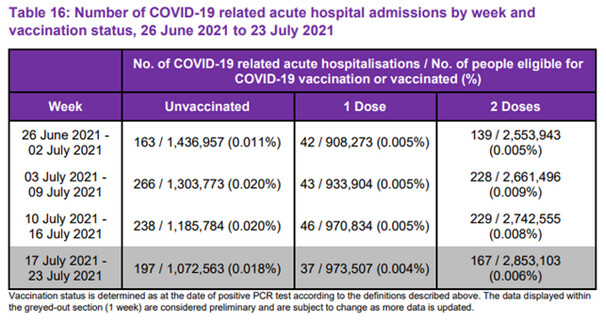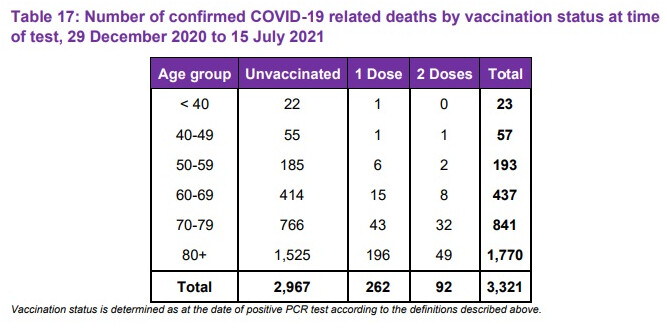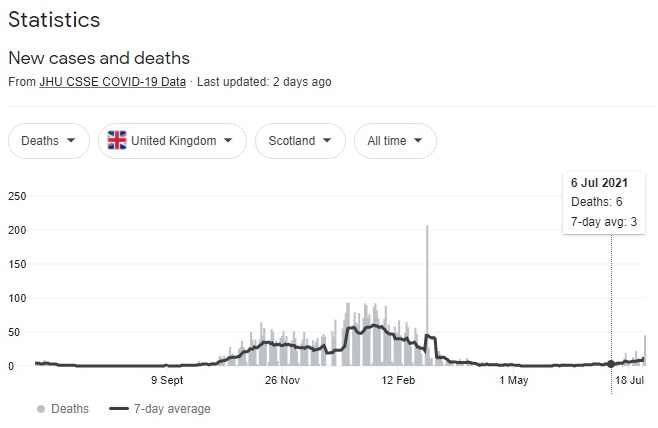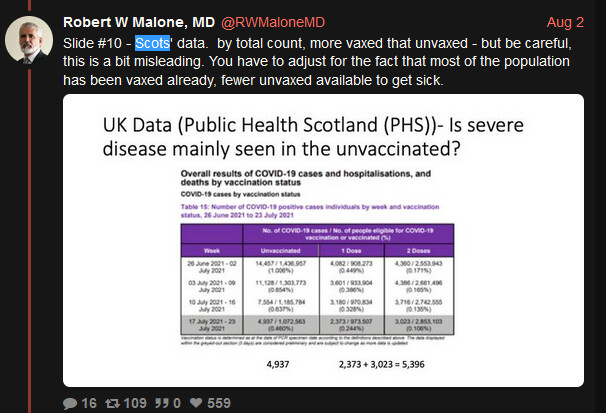The outcome of the Daily Expose analysis (which seems basically correct) is that
- the Public Health Scotland data presentations referred to on vaccinated vs unvaccinated populations are misleading, and that
- although the vaccine reduces covid ‘cases’ (as determined by PCR testing), those that are diagnosed with covid despite being vaccinated may have more hospitalisations and more deaths.
The data suggest that the recent vaccine data is genuinely worse than in the early part of the year, which is consistent with delta variant commentary.
Whereas the PHS presentations critiqued seem aimed at showing the experimental vaccines in a good light (burying the bad news), the DE analysis tries to compare like with like, and does the necessary digging
I think the problem I had reading the DE article online is the number of ‘vertical’ data connections, requiring a lot of scrolling; whether this condensed version is easier to follow remains to be seen!
The DE also interspersed commentary, analysis and criticism - as they are entitled to do - but I’ve only included the info necessary to understand the analysis.
Starting with ‘cases’, here is a table.

Progressing from June through July, the table shows that the percentage of ‘cases’ who are vaccinated rises; this isn’t unexpected as the percentage of people who are vaccinated rises.
Just to total up these time periods, as we’ll use them later:
Positive cases from 26 June to 23 July 2021 in Unvaccinated and those with 2 doses respectively:
38,067 unvaccinated, and 15,485 in those with 2 doses
A similar table provides this info for hospitalisations:

Again, totalling up the columns:
People hospitalised in the same time frame, Unvaccinated and those with 2 doses respectively:
863 763
So - here’s the thing.
The percentage of covid cases in the unvaccinated population is 863/38,067 or about 2.3%.
And the percentage of covid cases in the 2-dosed population is 763/15485 or about 5%.
This is a bit of a surprise.
The DE article itself points out a ‘slight flaw’, i.e. that there is an issue with the time lag between a confirmed covid case and a hospitalisation, saying
" but even so this clearly shows that the jabs are not quite doing what they claim to do “on the tin”."
which is a fair enough comment. Indeed, some covid cases will only be ‘confirmed’ upon hospitalisation, meaning for such patients there will be no delay. In the 4 week period of the above table cases rose by 25%, or about 6% a week - so the effect of the above time lag wouldn’t explain the apparent doubling in the percentage of cases.
…
So that’s ‘cases’, and hospitalisations by vaccination status; kind of End of Part One.
The DE’s point stands up as far as the data is concerned, and the PHS presentation, as DE notes gives a different appearance.
After some more commentary and points, the article moves on to deaths.
Deaths
PHS make a complete shift in the approach to counting the deaths.
The Daily Expose article is very critical of this shift.
Here’s what PHS say at this point, before presenting any data or graphs:

This definitely has a ring of ‘Nothing to see…’.
Credit is due to the Daily Expose for their perseverance - on reading that 89% deaths were in unvaccinated people, only very determined souls would expend the brainpower to plough on!
The DE are struck by the appearance of December at all in the deaths data - after PHS presented two analyses of cases and hospitalisations that were from June!
So DE likely smelt a rodent, probably related to December.
In the DE article there are graphs of numbers of vaccinations by month but hopefully it suffices to point out that as the vaccinations increased only slowly, for much of that early period the population as a whole was almost all unvaccinated.
There were plenty of covid deaths during this period; these would, apart from the slowly-growing number of vaccinated, be later simply called ‘unvaccinated covid deaths’, even though there was hardly any vaccinated group to compare them with.
This is the (misleading, DE say) effect of starting from December. It’s a kind of a mirror image of the period at the other end, where almost everyone is vaccinated and you can point to there being mainly vaccinated cases and deaths etc, because almost everyone is vaccinated, so the vaccine is thereby disadvantaged by the over-raw comparison. At the beginning with hardly any vaccinated, the vaccine is favoured.
In trying to indicate the effect of this problem, DE say:
" Can you see how Public Health Scotland have been able to manipulate the data on deaths in terms of vaccination status in favour of showing the vaccines are working by using these dates? The majority of Covid-19 deaths occurred prior to just 9% of Scotland’s population receiving the vaccine."
The 9% refers to the % vaccinated by 27 Jan 2021, which they choose as the convenience cutoff point before which vaccinations were low.
Rather than ‘a majority’ of deaths occurring before this point at which 9% were vaccinated, I get it to be about 45% (we’re only counting from 29 Dec, remember), but the point still stands.
So how would the deaths compare if this misleading December effect were adjusted for?

PHS’s 89% figure comes from 2967/3321. This needs to be adjusted to remove the slew of data from 29 Dec to 27 Jan…
PHS data is published daily here:
Link: Coronavirus (COVID-19): daily data for Scotland - gov.scot
From this (data not shown) there were 1421 covid deaths between Dec 29 and Jan 27, the period that the DE suggests was wrongly included due to low vaccinations so far. (In fact this choice of Jan 27 as the new starting-point is conservative, as the DE point out that even by 3 March only 31% had been double vaccinated, so this ‘period of dubiety’ could have been extended)
In addition to these 1421 deaths, a second adjustment seems indicated, as on March 3 PHS issued an upward adjustment of 173 deaths, with no indication of from where or when, or of vaccination status. Pending an explanation, this figure should be removed from both sides.
So subtracting the 1421 covid deaths and the 173 unexplained addition from the two big totals in the above Table 17, gives the number of deaths in the unvaccinated as 2967-1421-173=1373
…and the number of deaths as 3321-1421-173=1727.
If correct these adjustments reduce the % of deaths in the unvaccinated from 89% to 1373/1727, or 79.5%.
Without removing the 173 mystery deaths the figure would be about 2% higher.
This 79.5% figure should probably come down further. As noted the ‘dubious period’ above could be extended - in the low-vaccinated month following 27 January there were another 1200 deaths, so a further reduction could be reasonable. This would bring the 79.5% figure down, to (guesstimate) perhaps around 75%. When weighed up against risks, this isn’t such a robust figure.
How is the vaccine doing now?
If trying to present this data to show how effective the vaccine is now, as PHS seems to be doing, it also needs to be pointed out that the vaccine is doing less well lately, which is attributed to the delta variant.
The DE people are on this further angle, having noticed that the deaths graphs started to rise around 6 July:

Just looking at that little July rise, you have to credit DE with a certain vigilance!
To take a closer look at the period around 6 July and that of the most recent table (Table 7 above, which runs to July 15) they had the bright idea of getting the ‘Table 17’ from PHS’s previous statistical report and doing the subtractions.
This was the ‘Table 17’ from that previous report, noting the end date of 8 July:
And here are the deaths totals from the Table previously shown, which runs to July 15:
Unvaccinated: 2967. 1 dose: 262. 2 doses: 92.
Therefore in the period 8-15 July, the number of deaths in the unvaccinated is 2967-2962 = 5.
The number of deaths in 1 dose patients is 262-257, also 5.
The number of deaths in 2-dose patients is 92-64 = 28.
The boot’s now on the other foot. The DE point out that in terms of the game played by PHS at the beginning, this puts the vaccinated deaths in this admittedly brief period at (28+5)/38 or 87% of the total. And 74% are double vaccinated, with 13% single jabbed.
Finally the DE point out that this is despite the ‘fully vaccinated’ accounting for just 23% of the ‘cases’ in the previous 4 weeks. (To be pedantic I’d take just the last 1 or 2 weeks, but it’s still only 30% of the cases).
The last word has to go with DE, who issue their own rebuke, explanation and an “I told you so”
(emphasis added):
"
- By unpicking the data that Public Health Scotland have cleverly attempted to hide we have proven that you are more likely to be hospitalised and more likely to die if you are infected with Covid-19 after being vaccinated.
-
Antibody-dependent enhancement occurs when the antibodies generated during an immune response recognise and bind to a pathogen, but they are unable to prevent infection. Instead, these antibodies act as a “Trojan horse,” allowing the pathogen to get into cells and exacerbate the immune response.
- We were warned this is what the Covid-19 vaccines would cause based on the evidence produced in previous decades, the data we’ve just uncovered shows that the public should have heeded those warnings."
Fair enough? I think so. The time period for the last part is a bit short to try to draw definite conclusions about the data (except about the PHS presentation itself), and the explanation of Antibody-dependent enhancement may not be the only explanation, but it’s one that was extensively warned about and even predicted - new medications are supposed to adhere to the precautionary principle, yet this one is being rolled out hell for leather, even on to groups like children who did not feature in the trials, and who are not at risk from the disease.
Given this and the intense daily one-way pro-vaccine propaganda blitz, the warning is necessary and urgently needed.






 !
! }
} I want to rely on incompetence!
I want to rely on incompetence! ) despite the fact that I think there are some interesting bits of info here, and that PHS dropped the ball in a bad way, and that I think you’ve done a great job of clarifying a fairly confusing article, I’m just not sure what lesson to take away from the analysis. The crux of the issue to my mind comes down to a single basic fact - it’s almost useless to compare vaccinated and unvaccinated cohorts without a lot more careful matching of patient profiles. The data (to be fair, from both sides here, PHS and DE) ignore this and I’m therefore unsure what we learn from that… Unless I’ve just missed their point, which I might have.
) despite the fact that I think there are some interesting bits of info here, and that PHS dropped the ball in a bad way, and that I think you’ve done a great job of clarifying a fairly confusing article, I’m just not sure what lesson to take away from the analysis. The crux of the issue to my mind comes down to a single basic fact - it’s almost useless to compare vaccinated and unvaccinated cohorts without a lot more careful matching of patient profiles. The data (to be fair, from both sides here, PHS and DE) ignore this and I’m therefore unsure what we learn from that… Unless I’ve just missed their point, which I might have.
